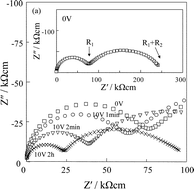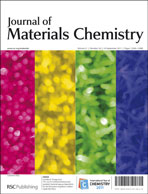The bulk and grain boundary conductivities of Ca(Ti1−xZnx)O3−x ceramics increase with time under a dc-bias voltage of ≤100Vcm−1 and at temperatures in the range 250 to 600 °C. This low field effect, which is not observed in undoped CaTiO3, is attributed to the nature of a defect structure that contains Zn located on a Ti site, giving rise to underbonded surrounding oxide ions that are readily ionised on application of a dc bias. The conduction is predominantly p-type since holes, located on oxygen as O− ions, are more mobile than both the ionised electrons which are trapped, probably at the sample surface, and oxygen vacancies which form as charge compensation for the Zn2+ acceptor dopant. The conductivity increase is reversible on removal of the dc bias. The electrical properties of the ceramics were modelled successfully using an equivalent electrical circuit consisting of a parallel combination of a resistor, R, capacitor, C, and constant phase element, CPE, to model the bulk response, in series with a similar circuit to model the grain boundary response. At the highest temperatures, an additional parallel RC element was added in series to model the sample-electrode response.

You have access to this article
 Please wait while we load your content...
Something went wrong. Try again?
Please wait while we load your content...
Something went wrong. Try again?


 Please wait while we load your content...
Please wait while we load your content...